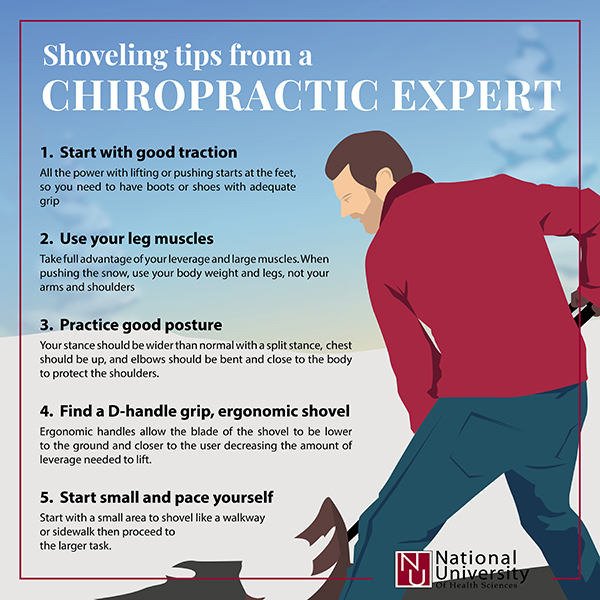Every winter, the annual task of shoveling results in thousands of injuries. According to the Consumer Product Safety Commission, more than 110,000 people went to doctors’ offices or clinics for snow-removal injuries in the U.S. in 2016.
Shoveling may seem like an easy and mundane task, but depending on how much there is to shovel, it can be surprisingly vigorous work. No matter how experienced you are at shoveling, performing this task incorrectly can lead to serious injuries for your back, shoulders, etc. To ensure you’re performing this activity safely and efficiently, here are a few tips from NUHS chiropractic alum Sean Gregory, DC.
-
Start with good traction
Falls on ice are high on my list of common winter injuries. Most people don’t think about the traction they need on the ground. Low traction will increase the risk of falls and even decrease the amount of snow a person is able to move. All the power with lifting or pushing starts at the feet, so you need to have boots or shoes with adequate grip. On especially icy days, I’ll put on my Kahtoola nanospikes over my boots to increase traction.

-
Use your leg muscles
While shoveling, many make the common mistake of twisting their torso and over utilizing their shoulders. As a result, shoulder and back injuries are also among the most common injuries that I see from snow shoveling. A lot of people try to lift and throw the snow using just their upper body. A better option is to take full advantage of your leverage and large muscles.
This means when pushing the snow, use your body weight and legs, not your arms and shoulders. Keep the elbows close to the body and push forward with your legs (again traction is important here). When you get to a point where you need to lift the snow, lift with your knees then stabilize your front hand and lower your back hand to maximize the leverage of the lift.
-
Practice good posture
When shoveling, your stance should be wider than normal with a split stance (one leg forward, one back) to help push the snow. Chest should be up and not bent forward in a hunched position. Elbows should be bent and close to the body to protect the shoulders from taking all of the force. When the elbows are locked out, any bump or catch on the ice can jar the shoulders.
-
Find a D-handle grip, ergonomic shovel
I like a push shovel with a D-handle grip at the end. Ergonomic handles can be beneficial also as they allow the blade of the shovel to be lower to the ground and closer to the user decreasing the amount of leverage needed to lift. The shovel should be long enough that the user does not have to hunch for the blade to be on the ground while keeping the front grip between the shovel blade and the midpoint of the handle.

It’s also helps to use cooking spray to lubricate your shovel’s blade so that snow doesn’t stick to it. I usually only have to do this the first snow of the year and it makes every time I use the shovel afterwards so much easier.
-
Start small and pace yourself
Before shoveling, stretching is always helpful. If you don’t have the time, start with a small area to shovel like a walkway or sidewalk then proceed to the larger task. The smaller task will show you how far you can move the snow before it becomes too heavy to comfortably lift and will allow you to pace yourself for the rest of your driveway.
Depending on your level of physical fitness and how much you need to shovel, you may need to take breaks. I use the breath test to determine if I’m shoveling too hard. If I’m out of breath and can’t have a conversation with a person while I’m shoveling, I’m probably working it too hard. Create time in your schedule to shovel if you know that you’ll be getting snow, don’t rush it and risk injury.
The good thing about shoveling during these COVD-19 times is that it helps get you out of the house and exercising. However, it’s important to keep in mind these tips make sure you’re performing the task safely.





0 Comments